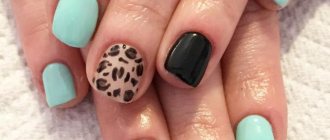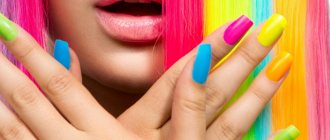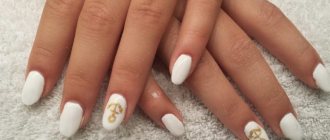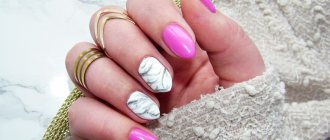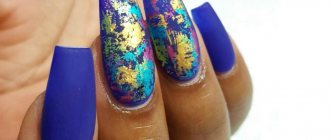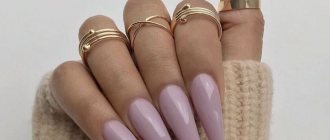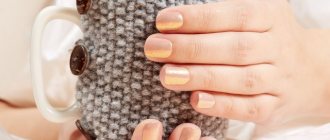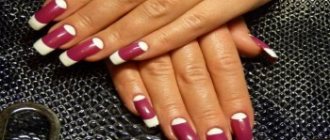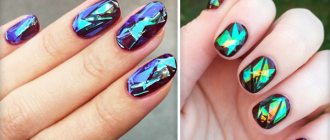From this article you will learn:
- What is the difference between biogel and gel polish?
- Which type of biogel is better to choose?
- How to properly strengthen and extend nails with biogel
- Is it possible to combine biogel with gel polish?
A neat and beautiful manicure is a must-have attribute of a modern well-groomed woman. But, unfortunately, not every representative of the fair half of humanity can boast of a successful shape and good condition of natural nails. In such cases, nail extensions with biogel may be a way out of the situation. Our article will tell you what this coating is, what types of it exist, and we will also talk about the intricacies of working with this material.
Differences between gel and biogel
There are not as many differences between them as it might seem at first glance. The biogel contains slightly less polymers, which do not have a very good effect on the nails themselves. But building up with its help still cannot be considered harmless. Just as with any extension, the nail plate is covered with a layer of various gels, which blocks access to oxygen. And it is because of this that the protective layer of the nail weakens. It is these qualities that can damage the plate, make it weaker, and it can become deformed. In view of this, girls with very weak nails are not recommended to do any type of extension, no matter what gel is used.
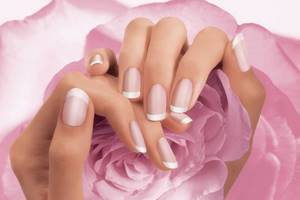
If we talk about operation, there are no special differences here either. These nails are strong and should be able to withstand any damage. The biogel remains bright until it is removed, no scratches are visible on it, and it does not change color. When it comes to correction, then dealing with biogel is much easier than with acrylic. It is very easy to make any design drawing on it.
Biogel is intended not only for nail extensions, it is also used to cover the nail plate so that the nails grow and do not break, that is, it serves as a kind of strengthener. But what we mean is strengthening the free edge of the nail due to the thickness of the gel. It is precisely because it becomes thicker and more resistant to any damage that it becomes more difficult to break.
Types of biogel
There are three main groups of biogel coating:
- Sculptural. Used for extensions and decoration. It contains silk extract, which strengthens and nourishes the nail plate. It becomes more elastic and durable. This biogel has an opaque, natural color.
- RoyalSealer is a finishing or, as it is also called, top coat that whitens the nail plate and also eliminates its yellowness and grayness due to its bluish tint. Adds shine and shine to manicure. It can be transparent or multi-colored. It is often applied over a French jacket.
- S-Biogel is an independent composition. Its use does not require the use of additional fixatives. This type, like the previous ones, helps strengthen the nail plate and is suitable for extensions. Sometimes available in a specific color palette.
Strengthening nails
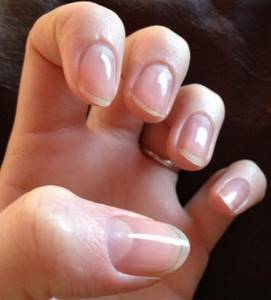
The strengthening procedure should begin with a hygienic manicure. At the very first stage, you need to remove the top layer of the nail, then apply a degreaser, and then a primer on it. Once it dries, you will need to apply the base biogel. This layer must be dried in an ultraviolet lamp. Then apply biogel, which is designed for leveling; after the lamp, this layer will be perfectly smooth. The last step is to apply the finishing biogel, which will give your nails shine and protect them from any damage. After the strengthening procedure itself, if desired, you can begin to create any design. Various designs using colored biogel will look beautiful.
Step-by-step application instructions
There is no need to choose a special time for nail strengthening procedures. The properties of biogel do not depend on the season or menstrual cycle. These and other myths have no scientific proof. A durable coating can be obtained only if the technology for applying it to the plate is followed.
- Preparatory process. At this stage there is no need for baths. It is important to work on a dry surface. This ensures good adhesion of the material. First, the old coating is removed. Next, the cuticle is put in order (the pterygium is pushed back with an orange stick, and pruning is done with forceps). After shaping the free edge, the file is processed. Preparation is completed by washing hands with soap and drying thoroughly.
- The stage of strengthening nails with biogel begins with treating your hands with an antiseptic. For these purposes, use Miramistin or other agents with a similar effect (for example, Chlorhexidine).
- Grinding plates using a buff. You need to do the work without fanaticism, just remove the shine. Passages are carried out over the entire surface of the nails, including areas adjacent to the cuticle and tips.
- Use a cloth soaked in degreaser to treat each plate.
- Applying the base. This is not a necessary step; often you can do without a base layer. If it is used, drying is performed next.
- Distribute the biogel in a thin layer using a brush. The ends are sealed.
- Drying in a lamp.
- Applying the second layer.
- Drying in a lamp.
- If a color coating is to be used, now is the time to apply it.
- Drying.
- Using a top coat followed by drying under a lamp.
- Removing the sticky layer is done using a napkin and degreaser.
- The session ends with treating the cuticle with oil for intense hydration.
All layers must be applied in a thin ball so as not to disrupt the process and speed of polymerization.
The biogel lasts on natural plates for about two weeks. This is subject to proper application and careful wearing.
Biogel extensions at home

If you decide to extend your nails yourself using biogel, then you will need to spend a little money on purchasing materials for this. Gel for nail extensions and for strengthening their tips have differences; if you decide to strengthen the free edge of the nail, then you need a composition just for this. Among other things, to extend your nails with biogel at home, you need some more items:
- File.
- Grinding for cutting off the top layer of the nail plate.
- A brush to remove dust after filing your nails.
- Orange sticks.
- Primer or primer.
- Degreaser.
- Forms for nail extensions or tips.
- S-biogel for extensions of one color.
- Biogel for creating drawings, if they are planned.
- Brushes and dots for design.
- Biogel top (top).
- Polisher for trimming extended nails.
- UV lamp.
Some believe that biogel nail extensions are not very durable, and that the gel itself may peel off. But if all stages of the process are completed correctly, then you can safely go through about a month with the finished manicure, until the next correction.
What is biogel
No sooner had acrylic gained popularity in manicure than a new coating appeared - gel. The material raised many questions among users, especially regarding the technique of removing it. It is more difficult than regular soaking. All shortcomings were taken into account when developing a new product - biogel.
The main component of the composition is natural resins. They, together with additional substances, form a liquid consistency. After application to the plate under exposure to an ultraviolet lamp, a polymer layer is formed that remains flexible. This prevents the coating from cracking when wearing a manicure. Biogel is removed by soaking. The advantage is that this product is suitable for any nails.
In addition to resins, the following is used in production:
- keratin;
- vitamins E, A, etc.;
- silk proteins.
Additives of natural origin ensure the restoration of damaged nail structure. Nutrition and hydration promotes rapid growth of the plate. After applying the coating, the effect lasts about 2-3 weeks. You should not remove the protruding part of the nail above the base of the finger with a file. The end side must be sealed, otherwise cracks and peeling will soon form along the edges. It will not be possible to make the plate shorter before removing the material.
It is comfortable to wear a manicure with biogel, as well as with other coatings. This is facilitated by a thin layer, lightweight material that does not require adaptation. Allergic reactions to the product have been recorded in isolated cases.
The process of nail extension with biogel
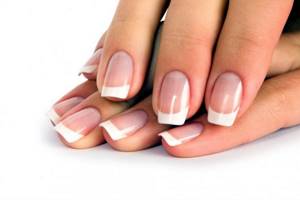
A few days before the procedure, it is advisable to remove the cuticles. It is not recommended to do this before the extension itself, as the material may peel off from the nail. You need to cut your nails very short; you can use clippers to speed up the process. You will also need to sharpen the nail to give it a beautiful shape. Remove the top layer on the nail plate, but you don’t need to grind it down too much, it’s advisable to just achieve a smooth surface. After all of the above, you need to degrease the nail. But it is important to slowly apply the degreaser so that it completely covers the surface. The next step is to apply the primer, but before further action you need to wait until it turns white, this is literally a few seconds. After this you need to glue the tips. It is important to take into account this point: after applying all the previous layers, you cannot touch the nail; if this cannot be avoided, then you first need to glue the tip, and then degrease and apply a primer.
Now you need to apply Gel S in two layers to form a beautiful nail plate. Then place your nails under the lamp for three minutes. Shape your nails and sharpen them to the desired shape. After this, apply the finishing biogel, and if you have a drawing in your project, then it should be done at this stage, and then dried under a lamp. If you do French, then you can use white biogel for extensions, and carry out the rest of the procedure with regular gel.
Nail extensions with biogel at home are quite simple to do. The main thing is to follow all the requirements so that your nails last longer in everyday life.
Biogel: features and benefits
As mentioned above, biosculpting gel is characterized by a low content of harmful components, as well as the presence of protein in its composition, which provides care and restoration of nails. In addition, the list of substances that have a positive effect on the structure of the nail includes tree resin, calcium and some groups of vitamins.
The gel is a soft and, as a rule, colorless mass, characterized by special plasticity. Using this material, you can model the shape of the nail, as well as cover the deformation.
It is important to know that there are different types of gels, for example, colored and transparent, reflective and matte, single-phase and multi-phase. The gel should be selected depending on the desired goals.

The main achievements of the technique of coating nails with biogel include:
- Emphasis on natural ingredients (wood resin, which strengthens the nail plate and prevents its damage; protein, which nourishes the nail and restores its natural structure; vitamins A and E, which supply nails with nutrients and have a positive effect on their growth; calcium, which makes nails stronger and elastic);
- “Breathing” of the plate under the gel layer. Despite the fact that the mass flows into natural pits located over the entire surface of the nail, air circulation does not stop and the nail continues to receive oxygen;
- There are no contraindications to this cosmetic service. Biogel nail extensions are allowed even for pregnant and lactating women. It has been proven that the gel does not cause allergic reactions and does not aggravate existing problems. In addition, especially sensitive people can easily undergo the procedure, since the product does not have an unpleasant odor;
- Long lasting results. The wearing time of the coating can be up to a month. And there is no need for a long rest, like after acrylic. But we must not forget that to maintain the effect, timely correction of the biogel must be carried out (approximately once every 3 weeks);
- Possibility of partial coverage during correction. To cover the overgrown part of the nail, it is enough to apply the gel only to it, without cutting off the rest of the material. It will be almost impossible to notice and distinguish these manipulations from complete coverage;
- Application time. Unlike acrylic, which takes hours to cover nails, biogel extensions take no more than an hour. And the process itself is similar to painting with regular varnish, which does not create unnecessary discomfort and does not require special skills.
The positive aspects of decorating nails with biogel are visible to the naked eye. The only drawback of this whole procedure is the instability of the gel in relation to chemical solutions, for example, acetone, cleaning products, and alcohol.
How to remove?
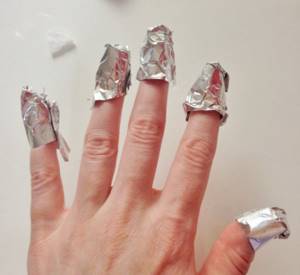
Extension with biogel is a fairly simple process; it is not too difficult to remove it from the surface of the nail; you just need a special liquid for this. First, you need to use a rough file to disturb the finishing layer, then apply liquid to the cotton wool, apply it to the nail and wrap it in foil. After about ten minutes the biogel will get wet, and after that it will be easy to remove it with an orange stick. Then you will still need to sand the surface of the nail with a buff. The nail plate is not injured after these procedures, so materials can be applied again. The procedure for removing nails does not take very long, about twenty minutes.
Correction
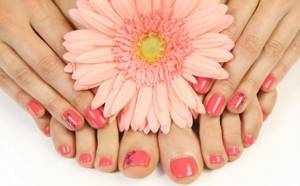
Many girls ask the question: “Is it possible to make a correction, or do I need to remove all the material and apply it again?” Some experts recommend taking it off and doing it again, as those layers remain, and you end up with layering. Others recommend making corrections after three weeks. According to their advice, you need to cut off the top layer of biogel and then apply it to the regrown part. But after several corrections, it is still recommended to completely remove it and build it up again.
Reviews
Reviews about biogel extensions are mostly good. Many girls are happy that their nails are protected, at the same time they are strengthened, and after removal they do not deteriorate at all. Much, of course, depends on the quality of the gel itself and on the artist who carries out the biogel extension procedure. If he has a lot of experience in this matter and knows how to carry out all the processes well, then the nails will not break or be damaged for a long time. And if you remove the biogel incorrectly, the removing liquid can harm the health of the nails, after which the healing process may be delayed. Biogel is not able to make long nails, as it is considered a soft material; only dense materials, such as acrylic and other types of gel, can handle this.
What clients and specialists say about biogel
Despite the very promising advertising of the new material, reviews of it are mixed. Some experts say that it does not irritate the skin and nail plate, is well tolerated, looks impressive, stays on the nails for a long time, and does not need frequent correction. Others report that biogel is a myth created to increase the cost of nail extensions. Experienced professionals say that the new material has a slightly different formula, which includes several natural substances (thanks to them the prefix “bio” appeared), but it also contains chemical compounds that have a negative effect on the nail plate.
Honest masters report in their reviews that correction when performing biogel extensions should be carried out as often as when using regular gel. The advertised material strengthens the plate due to a large number of layers. However, when they are removed (if such a need arises), the nails become very thin, and they have to be restored for a long time.
Clients also report not only the advantages of biogel, but also its disadvantages. Ladies are advised to contact only an experienced master. Otherwise, you may encounter the fact that the biogel will crack on your nails within a week after extension. In addition, this procedure using a new material costs much more than using a conventional gel.
Author: Natalya Ivanova December 31, 2018

